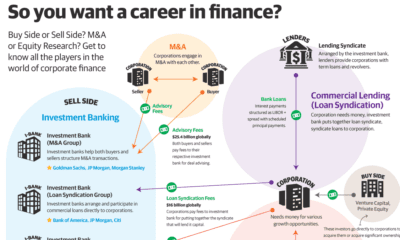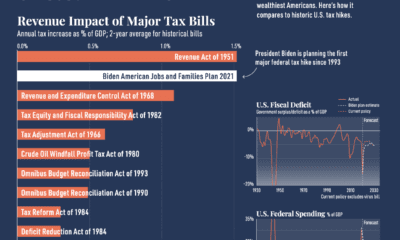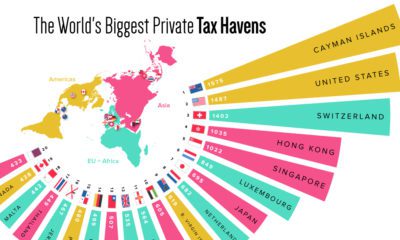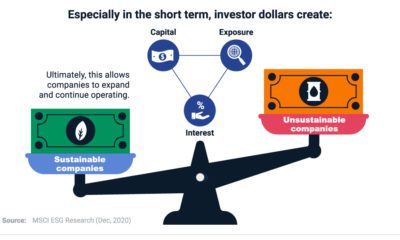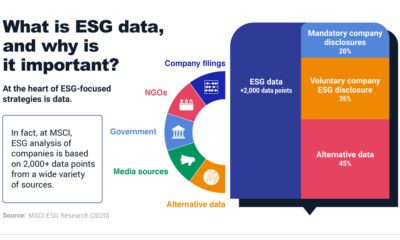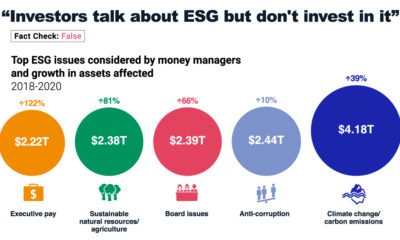Throughout the U.S., unrealized capital gains have significant tax implications with enormous potential. Unrealized capital gains occur when the value of an asset has gone up on paper, but has not yet been sold for a profit. Taxes are triggered once the asset has been sold. Investors can offset or defer these taxes in a few ways, including one new strategy: investing in opportunity zones. Today’s infographic from Bedford Funds explains what opportunity zone funds are, their core benefits, and their potential impact across the country.
What is an Opportunity Zone?
Opportunity zones are U.S. Census tracts whose citizens experience economic distress. Originating in the 2017 Tax Cuts and Jobs Act, they offer the potential to connect long-term capital with low-income communities across the country to drive return and impact. How are opportunity zones chosen? The initial base is low-income census tracts, which have:
Poverty rates of at least 20%; or Median family incomes lower than 80% of the surrounding area
The state’s governor or chief executive then nominates up to 25% of these areas as opportunity zones. Nationwide, a total of 8,700 opportunity zones exist, and 7.9 million of the areas’ residents live in poverty. Overall, 35 million people live in these opportunity zones. There are a number of disparities between opportunity zones and notional averages across key variables: *Adult with Bachelor’s degree or higher It’s evident these cities could benefit from increased investment.
What is an Opportunity Zone Fund?
An opportunity zone fund (OZF) is an investment vehicle that provides tax benefits for private capital to help revitalize economically distressed communities. Both operating businesses and real estate are eligible for investment. Many investor types may take advantage of opportunity zone funds:
Corporations– Also includes partnerships Accredited investors– Defined as high net worth individuals, brokers, and trusts Nonresident foreign investors– Only on capital gains earned in the U.S. Retail investors– Through funds that have lower minimums, though options are more limited
In addition to their wide eligibility, OZFs have a number of potential benefits.
Benefits
Tax breaks on capital gains can be organized into three tiers:
Initial Tax Deferral– Once the previously-earned capital gains are channeled into a qualifying OZF, federal tax is deferred until December 31, 2026 or the date the investment is sold— whichever comes sooner Step-Up In Basis– 10% of the original capital gains will be excluded from federal taxes if an investment is held for five years Capital Gains Tax Exclusion– Federal tax on capital gains earned within the OZF is 100% eliminated if an investment is held for 10 years
All things being equal, OZFs realize after-tax outcomes that are over 40% higher than a standard portfolio investment. For example, the potential after-tax value of a $100 investment after a 10-year holding period would be as follows. *Note: assumes long-term federal capital gains tax rate of 23.8%, no state income tax, and annual appreciation of 7% for both the OZF and alternative investment. While it takes a few years to realize these tax benefits, OZFs have long-term horizons to encourage sustained investment with a lasting impact. The result is the potential for sustainable and equitable wealth creation.
Future Impact
Although real estate investments have captured significant attention, recent regulation has clarified that operating businesses are also eligible OZF investments. By investing in businesses, OZFs can have a direct impact on economic growth and job creation. Ultimately, OZFs have the potential to catalyze collective impact through their scalable operating company and real estate investments. Working directly with community leaders, OZFs can help drive long-term rejuvenation from within, versus gentrification from outside forces. Opportunity zone funds are projected to raise $44 billion in capital designed specifically to invest in this future growth. on Both figures surpassed analyst expectations by a wide margin, and in January, the unemployment rate hit a 53-year low of 3.4%. With the recent release of February’s numbers, unemployment is now reported at a slightly higher 3.6%. A low unemployment rate is a classic sign of a strong economy. However, as this visualization shows, unemployment often reaches a cyclical low point right before a recession materializes.
Reasons for the Trend
In an interview regarding the January jobs data, U.S. Treasury Secretary Janet Yellen made a bold statement: While there’s nothing wrong with this assessment, the trend we’ve highlighted suggests that Yellen may need to backtrack in the near future. So why do recessions tend to begin after unemployment bottoms out?
The Economic Cycle
The economic cycle refers to the economy’s natural tendency to fluctuate between periods of growth and recession. This can be thought of similarly to the four seasons in a year. An economy expands (spring), reaches a peak (summer), begins to contract (fall), then hits a trough (winter). With this in mind, it’s reasonable to assume that a cyclical low in the unemployment rate (peak employment) is simply a sign that the economy has reached a high point.
Monetary Policy
During periods of low unemployment, employers may have a harder time finding workers. This forces them to offer higher wages, which can contribute to inflation. For context, consider the labor shortage that emerged following the COVID-19 pandemic. We can see that U.S. wage growth (represented by a three-month moving average) has climbed substantially, and has held above 6% since March 2022. The Federal Reserve, whose mandate is to ensure price stability, will take measures to prevent inflation from climbing too far. In practice, this involves raising interest rates, which makes borrowing more expensive and dampens economic activity. Companies are less likely to expand, reducing investment and cutting jobs. Consumers, on the other hand, reduce the amount of large purchases they make. Because of these reactions, some believe that aggressive rate hikes by the Fed can either cause a recession, or make them worse. This is supported by recent research, which found that since 1950, central banks have been unable to slow inflation without a recession occurring shortly after.
Politicians Clash With Economists
The Fed has raised interest rates at an unprecedented pace since March 2022 to combat high inflation. More recently, Fed Chairman Jerome Powell warned that interest rates could be raised even higher than originally expected if inflation continues above target. Senator Elizabeth Warren expressed concern that this would cost Americans their jobs, and ultimately, cause a recession. Powell remains committed to bringing down inflation, but with the recent failures of Silicon Valley Bank and Signature Bank, some analysts believe there could be a pause coming in interest rate hikes. Editor’s note: just after publication of this article, it was confirmed that U.S. interest rates were hiked by 25 basis points (bps) by the Federal Reserve.
